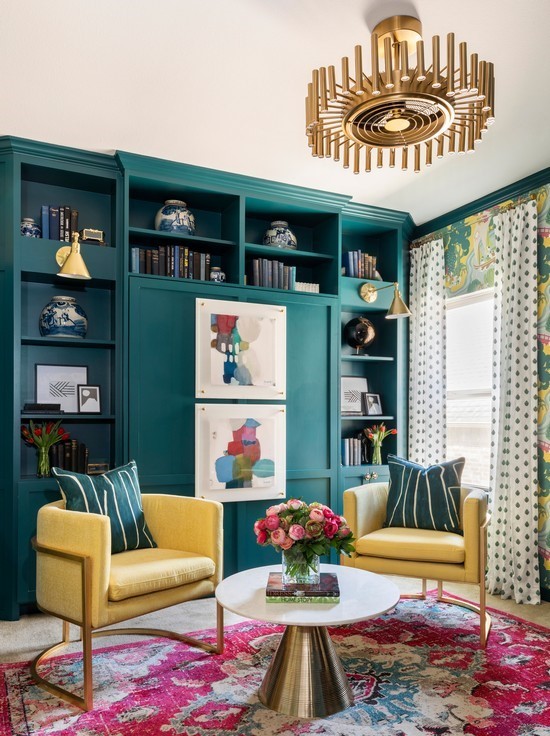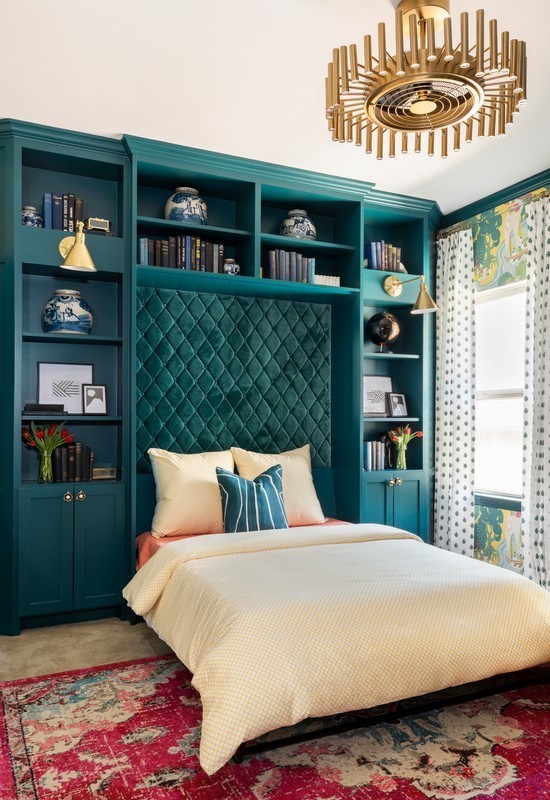The office that Veronica Solomon designed
for a couple in suburban
Houston has everything.
اضافة اعلان
There is a sitting area with citron-yellow accent
chairs and a coffee table, a desk with floral hardware, splashy patterns in
bold colors on the rug and wallpaper, and a custom neon sign in glowing pink.
The office also contains a secret: The teal wall
unit featuring built-in shelving and an artwork display actually conceals a
full-size Murphy bed.
Now the couple has a three-in-one room where the
wife, a retired
basketball coach, can work and entertain, and overnight guests
can comfortably sleep.
“The bed is really a great use of space, and a great
way to make a room really function for a lot of different things,” said
Solomon, founder of Casa Vilora Interiors.
Murphy beds have always served as space-savers in
small urban apartments. However, as more suburbanites have been working from
home, even they have turned to Murphy beds as a way to squeeze the most out of
home offices while keeping Zoom call backgrounds free from the rather intimate
piece of furniture.
According to market research from the New York-based
Resource Furniture, which specializes in transforming furniture, about 40
percent of its clients who bought wall beds last year live in single-family
homes with three or more bedrooms. From 2020 to 2021, Resource’s sales
increased 60 percent, with wall beds accounting for over half that increase.
 A wall unit conceals a Murphy bed in a Houston home office designed by Veronica Solomon of Casa Vilora Interiors.
A wall unit conceals a Murphy bed in a Houston home office designed by Veronica Solomon of Casa Vilora Interiors.
The Murphy bed was invented by William Lawrence
Murphy, who patented his design in 1911. According to Smithsonian magazine, the
bed was created to avoid a salacious situation: Murphy wanted to entertain his
opera-singer sweetheart at his San Francisco studio, but propriety demanded
that his bed be out of sight. His solution? Folding the bed into the closet.
Despite their intriguing origin story, Murphy beds
have historically been played for laughs in pop culture — even as far back as
the 1916 film “One A.M.”, which shows
Charlie Chaplin drunkenly fumbling around
a floppy wall bed. Eventually, Murphy beds became so ubiquitous that in 1989, a
federal appeals court in New York found that the name had grown too generic to
retain its trademark. Now, “Murphy bed” and “wall bed” are used
interchangeably.
Economic conditions also play a role in the item’s
popularity. Challie Stillman, vice president for sales and design at Resource
Furniture, noted that the company’s last Murphy-bed “marquee moment” was during
the 2008 recession. With another recession likely, Stillman said Resource is
forecasting a similar rise in sales.
 A Murphy bed in a Houston home office designed by Veronica Solomon of Casa Vilora Interiors.
A Murphy bed in a Houston home office designed by Veronica Solomon of Casa Vilora Interiors.
Murphy beds come in a range of options, and can
accommodate any size mattress, from twin to king. Prices range from about
$1,000 to $20,000, which includes frills such as a couch and shelving. While
the beds once had a reputation for being flimsy, today piston and spring
mechanisms make them more secure.
Ryan Jestin, an owner of the Mod Barn, a Los Angeles
furniture design store, prefers the spring mechanism. “It’s just one panel that
folds down with the mattress, so it looks much more visually appealing this
way,” he said.
There are prefabricated options: Michelle Allen, a
49-year-old product designer, bought a queen-size version from Amazon for
around $1,800 to install in the art studio of her Vancouver home. Her husband
and son put the bed together in about three or four hours, she estimated. “I’m
fairly handy, but you probably wanted somebody with a little bit of tool
experience,” Allen said.
Bespoke varieties exist, too, and Jestin has
designed Murphy beds for more than 20 years. He enjoys working with them
because “they transition your room so much”.
Some of his designs feature sliding bookcases, and
others have desks attached to the outside that fold up when the beds come down.
He has even built a kid’s playhouse with a Murphy bed inside (and an
interactive Lego front).
In addition to their functionality, another key to
Murphy beds’ appeal is the element of surprise they add to a room.
Genevieve White Carter and Cy Carter, married
interior designers who live in St. James, New York, designed a home Venice,
California, where they color-matched a Murphy bed to a pink oxford shirt. When
the bed is up, even the built-in shelves with knickknacks are concealed. “I do
think that there’s kind of a fun, secret-y element about it, as well as it
being practical and utilitarian,” Cy Carter said.
The designers have since pitched Murphy beds to several
residential and commercial clients — often receiving eager responses. “The
client is like a little kid,” Cy Carter said. “I think that there is a part of
it of like, ‘Oh look, this whole other room comes down, like a secret
passageway.’”
Read more Property
Jordan News



